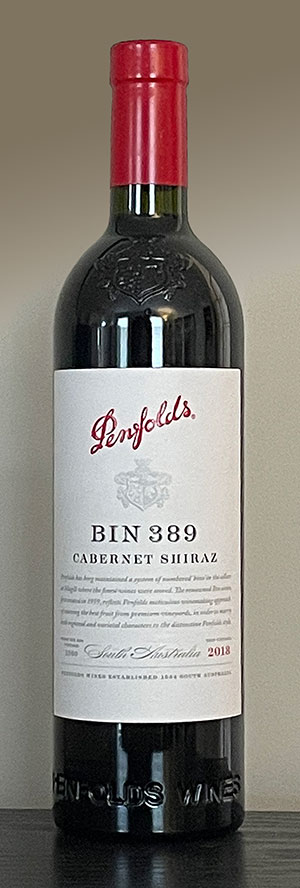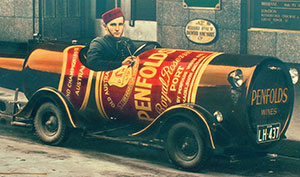
Penfolds Bin 389 Cabernet Shiraz 2018
Until Yellow Tail precipitated the boom in “critter wines” in 2000, it can be argued that Penfolds was just about synonymous with Australian wine in the U.S. The label is ubiquitous here, in both grocery stores and fine wine shops. Prices range from about $12 per bottle for the Koonunga Hill Shiraz-Cabernet, to $700 for the legendary Grange, and everything in between. (That $700 is doubly amazing, because just five or six years ago Grange was “only” about $200.) The selections are mostly reds plus a few whites and even a tawny Port.
Founders Dr. Christopher and Mary Penfold immigrated to Australia from England in 1844, bringing their own French vine cuttings. Not long after, their fledgling vineyard was officially established as the Penfolds wine company at the 500-acre Magill Estate in Adelaide.
The Penfolds were believers in the medicinal benefits of wine, and they planned to concoct a wine tonic for the treatment of anemia. Initially, they produced fortified wines in the style of Sherry and Port for Dr Penfold’s patients. The operation enjoyed early growth, and since Dr Penfold was focused on his medical practice, much of the running of the winery was delegated to Mary Penfold, including the cultivation of the vines and wine blending. On Christopher’s death in 1870, Mary assumed total responsibility for the winery. According to one historical account, by that time the business had “grown to over 60 acres with several different grape varieties including Grenache, Vverdelho, Mataro (aka Mourvedre), Frontignac and Pedro Ximenez,” and the estate was “producing both sweet and dry red and white table wines with a growing market in the eastern Australian colonies of Victoria and New South Wales.” Clarets and Rieslings were especially popular.
During her tenure, Mary engaged in experimentation, explored new methods of wine production, looked into ways of combating diseases like phylloxera, and engaged a cellar master by the name of Joseph Gillard.
Penfolds was producing a 
third of all South Australia’s wine by the time Mary Penfold retired in 1884, when the company passed to her daughter Georgina and son-in-law Thomas Hyland. By 1907, Penfolds had become South Australia’s largest winery (It is still big, but it no longer holds that position. That distinction now goes to Casella winery in Yenda, NSW of YellowTail fame. ) Eventually, the business was passed onto their two sons and two daughters. The company became public in 1962, and the Penfold family retained a controlling interest until 1976.
In 1948, Max Schubert
became the company’s first Chief Winemaker. A loyal company man and true innovator, Schubert would propel Penfolds onto the global stage with his creation of Penfolds Grange. (That’s a story for another time, if I can ever get my hands on a bottle. Hey, Penfolds! A little help here?)
In 1959, while Schubert was perfecting his Grange experiment in secret, Penfolds’ tradition of ‘bin wines’ began. The first, a Shiraz with grapes from the company’s own Barossa Valley vineyards, was simply named after the storage area of the cellars where it was aged.
In 1988, after three decades of Grange’s success and growth into a wine world icon, Schubert was named Decanter magazine’s Man of the Year, and on the 50th anniversary of its creation, Penfolds Grange was given a heritage listing in South Australia.
In 1976, control of Penfolds was acquired by Tooth and Co., a brewer based in New South Wales, which in 1982 became part of the Adelaide Steamship Company Group. In 1990, SA Brewing purchased Adelaide Steamship’s wineries. Later, SA Brewing was divided into three separate entities: the wine assets were named Southcorp Wine.
Southcorp Wines became a part of the Foster’s Group in 2005. Fosters has historically been much more involved in beer than wine, and the wine operation faltered for six years until 2011 . At that time Fosters decided to divest its wine holdings, and they were sold to Treasury Wine Estates, headquartered in Melbourne, becoming Penfolds current owner. The chief winemaker since 2002 has been Peter Gago.
Penfolds Bin 389 Cabernet Shiraz 2018
Named after its original binning compartment at the Magill cellars, this wine has been called “Baby Grange.” I can’t vouch for that since I’ve never had Grange, but, if true, at $60 vs. $700 it’s a bargain. The first Bin 389 was created by Max Schubert in 1960, the same year he was given permission to resume Grange production. The two wines came up together, sharing sources and techniques. Also “Baby Grange” because some components of the wine are matured in the same barrels that held the previous vintage of Grange, but I think that’s just silly. Regardless, the barrels are 38% new American oak. Fruit was sourced from McLaren Vale, Barossa Valley, Wrattonbully, and Padthaway. The blend is 57% Cabernet Sauvignon and 43% Shiraz.
This pours a nearly opaque purple. The nose offers rich blackberry and cassis. These continue on the palate, with some strapping tannins (that settle down in a couple of hours) and excellent acidity. This wine is just the way I like my reds, and even at 60 bucks is a great value if you can afford it. ABV is 14.5%
Back to blog posts: winervana.com/blog/
